Configure cross-tenant access settings for B2B collaboration
Use External Identities cross-tenant access settings to manage how you collaborate with other Microsoft Entra organizations through B2B collaboration. These settings determine both the level of inbound access users in external Microsoft Entra organizations have to your resources, and the level of outbound access your users have to external organizations. They also let you trust multifactor authentication (MFA) and device claims (compliant claims and Microsoft Entra hybrid joined claims) from other Microsoft Entra organizations. For details and planning considerations, see Cross-tenant access in Microsoft Entra External ID.
Important
Microsoft is beginning to move customers using cross-tenant access settings to a new storage model on August 30, 2023. You may notice an entry in your audit logs informing you that your cross-tenant access settings were updated as our automated task migrates your settings. For a brief window while the migration processes, you will be unable to make changes to your settings. If you are unable to make a change, you should wait a few moments and try the change again. Once the migration completes, you will no longer be capped with 25kb of storage space and there will be no more limits on the number of partners you can add.
Before you begin
Caution
Changing the default inbound or outbound settings to Block access could block existing business-critical access to apps in your organization or partner organizations. Be sure to use the tools described in Cross-tenant access in Microsoft Entra External ID and consult with your business stakeholders to identify the required access.
- Review the Important considerations section in the cross-tenant access overview before configuring your cross-tenant access settings.
- Use the tools and follow the recommendations in Identify inbound and outbound sign-ins to understand which external Microsoft Entra organizations and resources users are currently accessing.
- Decide on the default level of access you want to apply to all external Microsoft Entra organizations.
- Identify any Microsoft Entra organizations that need customized settings so you can configure Organizational settings for them.
- If you want to apply access settings to specific users, groups, or applications in an external organization, you need to contact the organization for information before configuring your settings. Obtain their user object IDs, group object IDs, or application IDs (client app IDs or resource app IDs) so you can target your settings correctly.
- If you want to set up B2B collaboration with a partner organization in an external Microsoft Azure cloud, follow the steps in Configure Microsoft cloud settings. An admin in the partner organization needs to do the same for your tenant.
- Both allow/block list and cross-tenant access settings are checked at the time of invitation. If a user's domain is on the allowlist, they can be invited, unless the domain is explicitly blocked in the cross-tenant access settings. If a user's domain is on the blocklist, they can't be invited regardless of the cross-tenant access settings. If a user isn't on either list, we check the cross-tenant access settings to determine whether they can be invited.
Configure default settings
Tip
Steps in this article might vary slightly based on the portal you start from.
Default cross-tenant access settings apply to all external tenants for which you haven't created organization-specific customized settings. If you want to modify the Microsoft Entra ID-provided default settings, follow these steps.
Sign in to the Microsoft Entra admin center as at least a Security Administrator.
Browse to Identity > External Identities > Cross-tenant access settings, then select Cross-tenant access settings.
Select the Default settings tab and review the summary page.

To change the settings, select the Edit inbound defaults link or the Edit outbound defaults link.

Modify the default settings by following the detailed steps in these sections:
Add an organization
Follow these steps to configure customized settings for specific organizations.
Sign in to the Microsoft Entra admin center as at least a Security Administrator.
Browse to Identity > External Identities > Cross-tenant access settings, then select Organizational settings.
Select Add organization.
On the Add organization pane, type the full domain name (or tenant ID) for the organization.
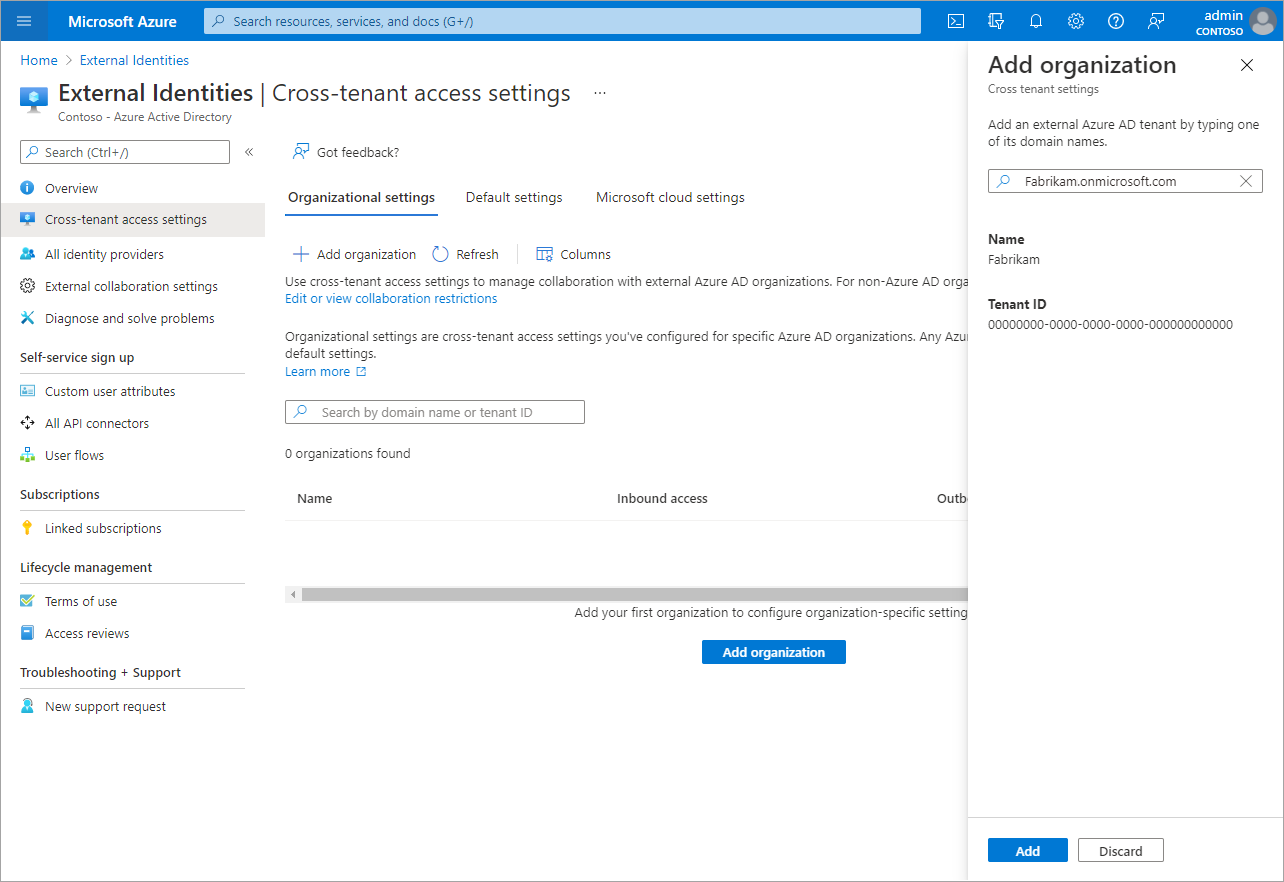
Select the organization in the search results, and then select Add.
The organization appears in the Organizational settings list. At this point, all access settings for this organization are inherited from your default settings. To change the settings for this organization, select the Inherited from default link under the Inbound access or Outbound access column.
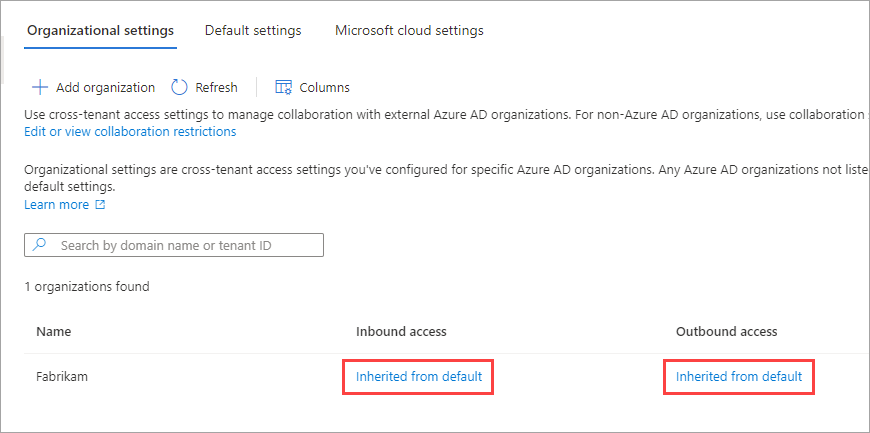
Modify the organization's settings by following the detailed steps in these sections:
Modify inbound access settings
With inbound settings, you select which external users and groups are able to access the internal applications you choose. Whether you're configuring default settings or organization-specific settings, the steps for changing inbound cross-tenant access settings are the same. As described in this section, you navigate to either the Default tab or an organization on the Organizational settings tab, and then make your changes.
Sign in to the Microsoft Entra admin center as at least a Security Administrator.
Browse to Identity > External Identities > Cross-tenant access settings.
Navigate to the settings you want to modify:
- Default settings: To modify default inbound settings, select the Default settings tab, and then under Inbound access settings, select Edit inbound defaults.
- Organizational settings: To modify settings for a specific organization, select the Organizational settings tab, find the organization in the list (or add one), and then select the link in the Inbound access column.
Follow the detailed steps for the inbound settings you want to change:
To change inbound B2B collaboration settings
Sign in to the Microsoft Entra admin center as at least a Security Administrator.
Browse to Identity > External Identities > Cross-tenant access settings, then select Organizational settings
Select the link in the Inbound access column and the B2B collaboration tab.
If you're configuring inbound access settings for a specific organization, select an option:
Default settings: Select this option if you want the organization to use the default inbound settings (as configured on the Default settings tab). If customized settings were already configured for this organization, you need to select Yes to confirm that you want all settings to be replaced by the default settings. Then select Save, and skip the rest of the steps in this procedure.
Customize settings: Select this option if you want to customize the settings to enforce for this organization instead of the default settings. Continue with the rest of the steps in this procedure.
Select External users and groups.
Under Access status, select one of the following:
- Allow access: Allows the users and groups specified under Applies to to be invited for B2B collaboration.
- Block access: Blocks the users and groups specified under Applies to from being invited to B2B collaboration.

Under Applies to, select one of the following:
- All external users and groups: Applies the action you chose under Access status to all users and groups from external Microsoft Entra organizations.
- Select external users and groups (requires a Microsoft Entra ID P1 or P2 subscription): Lets you apply the action you chose under Access status to specific users and groups within the external organization.
Note
If you block access for all external users and groups, you also need to block access to all your internal applications (on the Applications tab).
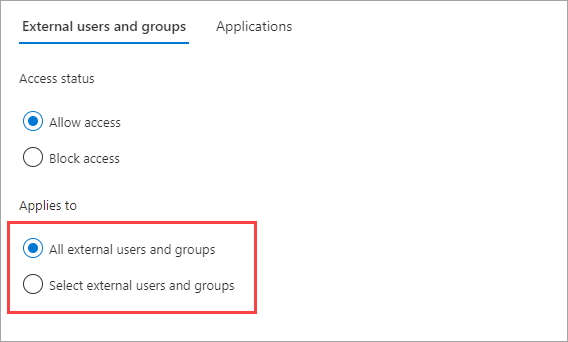
If you chose Select external users and groups, do the following for each user or group you want to add:
- Select Add external users and groups.
- In the Add other users and groups pane, in the search box, type the user object ID or group object ID you obtained from your partner organization.
- In the menu next to the search box, choose either user or group.
- Select Add.
Note
You cannot target users or groups in inbound default settings.
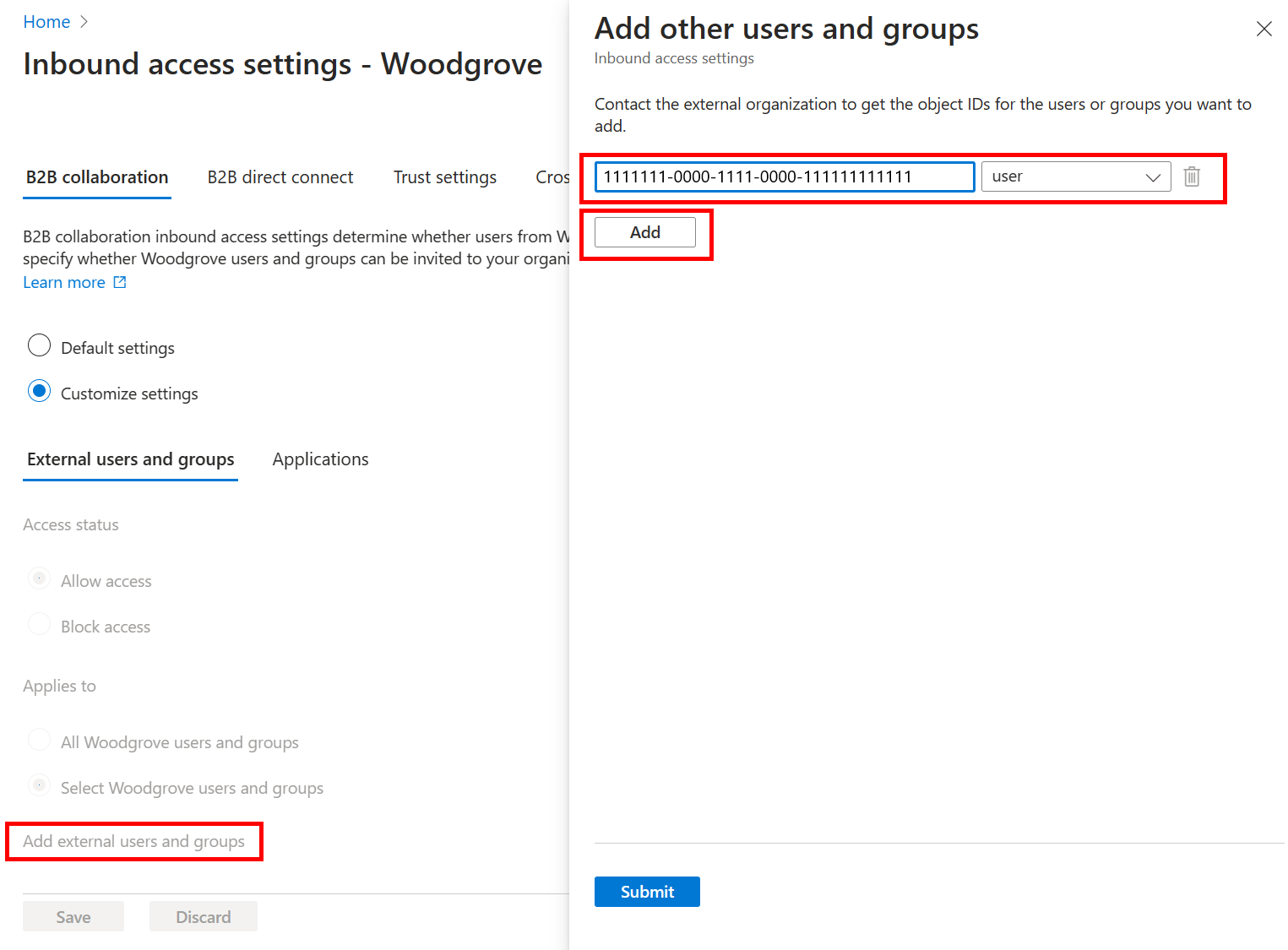
When you're done adding users and groups, select Submit.
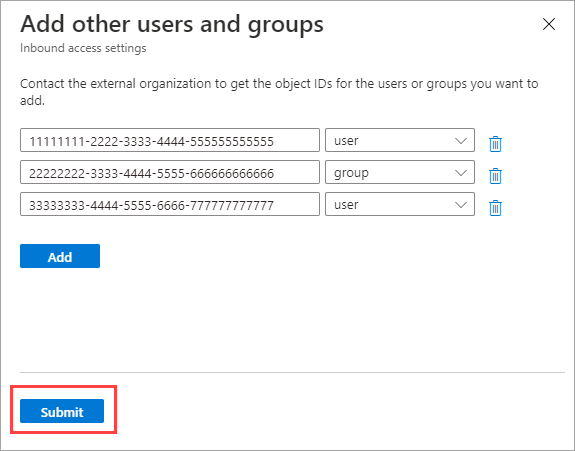
Select the Applications tab.
Under Access status, select one of the following:
- Allow access: Allows the applications specified under Applies to to be accessed by B2B collaboration users.
- Block access: Blocks the applications specified under Applies to from being accessed by B2B collaboration users.
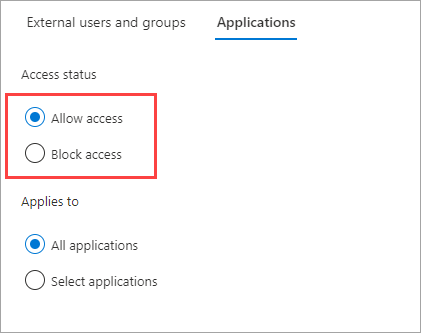
Under Applies to, select one of the following:
- All applications: Applies the action you chose under Access status to all of your applications.
- Select applications (requires a Microsoft Entra ID P1 or P2 subscription): Lets you apply the action you chose under Access status to specific applications in your organization.
Note
If you block access to all applications, you also need to block access for all external users and groups (on the External users and groups tab).
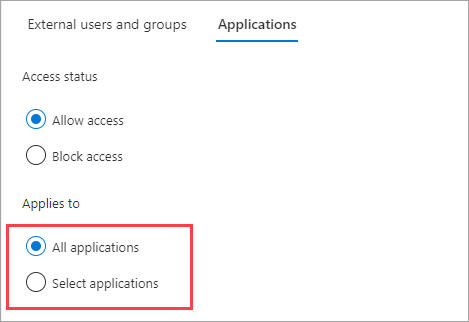
If you chose Select applications, do the following for each application you want to add:
- Select Add Microsoft applications or Add other applications.
- In the Select pane, type the application name or the application ID (either the client app ID or the resource app ID) in the search box. Then select the application in the search results. Repeat for each application you want to add.
- When you're done selecting applications, choose Select.

Select Save.
Add the Microsoft Admin Portals app to B2B collaboration
You can't directly add the Microsoft Admin Portals app to the inbound and outbound cross-tenant access settings in the Microsoft Entra admin center. However, you can add the apps listed below individually by using the Microsoft Graph API.
The following apps are part of the Microsoft Admin Portals app group:
- Azure Portal (c44b4083-3bb0-49c1-b47d-974e53cbdf3c)
- Microsoft Entra Admin Center (c44b4083-3bb0-49c1-b47d-974e53cbdf3c)
- Microsoft 365 Defender Portal (80ccca67-54bd-44ab-8625-4b79c4dc7775)
- Microsoft Intune Admin Center (80ccca67-54bd-44ab-8625-4b79c4dc7775)
- Microsoft Purview Compliance Portal (80ccca67-54bd-44ab-8625-4b79c4dc7775)
Configure redemption order
To customize the order of identity providers that your guest users can use to sign in when they accept your invitation, follow these steps.
Sign in to the Microsoft Entra admin center using a Global Administrator or Security Administrator account. Then open the Identity service on the left hand side.
Select External Identities > Cross-tenant access settings.
Under Organizational settings select the link in the Inbound access column and the B2B collaboration tab.
Select the Redemption order tab.
Move the identity providers up or down to change the order in which your guest users can sign in when they accept your invitation. You can also reset the redemption order to the default settings here.
Select Save.
You can also customize the redemption order via the Microsoft Graph API.
Open the Microsoft Graph Explorer.
Sign in with a Global Administrator or Security Administrator account to your resource tenant.
Run the following query to get the current redemption order:
GET https://graph.microsoft.com/beta/policies/crossTenantAccessPolicy/defaultIn this example, we'll move the SAML/WS-Fed IdP federation to the top of the redemption order above Microsoft Entra identity provider. Patch the same URI with this request body:
{ "invitationRedemptionIdentityProviderConfiguration": { "primaryIdentityProviderPrecedenceOrder": ["ExternalFederation ","AzureActiveDirectory"], "fallbackIdentityProvider": "defaultConfiguredIdp " } }To verify the changes run the GET query again.
To reset the redemption order to the default settings, run the following query:
{ "invitationRedemptionIdentityProviderConfiguration": { "primaryIdentityProviderPrecedenceOrder": [ "azureActiveDirectory", "externalFederation", "socialIdentityProviders" ], "fallbackIdentityProvider": "defaultConfiguredIdp" } }
SAML/WS-Fed federation (Direct federation) for Microsoft Entra ID verified domains
You can now add your enlisted Microsoft Entra ID verified domain to set up the direct federation relationship. First you need to set up the Direct federation configuration in the admin center or via the API. Make sure that the domain isn't verified in the same tenant. Once the configuration is set up, you can customize the redemption order. The SAML/WS-Fed IdP is added to the redemption order as the last entry. You can move it up in the redemption order to set it above Microsoft Entra identity provider.
Prevent your B2B users from redeeming an invite using Microsoft accounts
To prevent your B2B guest users from redeeming their invite using their existing Microsoft accounts or creating a new one to accept the invitation, follow the steps below.
Sign in to the Microsoft Entra admin center using a Global Administrator or Security Administrator account. Then open the Identity service on the left hand side.
Select External Identities > Cross-tenant access settings.
Under Organizational settings select the link in the Inbound access column and the B2B collaboration tab.
Select the Redemption order tab.
Under Fallback identity providers disable Microsoft service account (MSA).
Select Save.
You need to have at least one fallback identity provider enabled at any given time. If you want to disable Microsoft accounts, you have to enable email one-time passcode. You can't disable both fallback identity providers. Any existing guest users signed in with Microsoft accounts continue using it during subsequent sign-ins. You need to reset their redemption status for this setting to apply.
To change inbound trust settings for MFA and device claims
Select the Trust settings tab.
(This step applies to Organizational settings only.) If you're configuring settings for an organization, select one of the following:
Default settings: The organization uses the settings configured on the Default settings tab. If customized settings were already configured for this organization, select Yes to confirm that you want all settings to be replaced by the default settings. Then select Save, and skip the rest of the steps in this procedure.
Customize settings: You can customize the settings to enforce for this organization instead of the default settings. Continue with the rest of the steps in this procedure.
Select one or more of the following options:
Trust multi-factor authentication from Microsoft Entra tenants: Select this checkbox to allow your Conditional Access policies to trust MFA claims from external organizations. During authentication, Microsoft Entra ID checks a user's credentials for a claim that the user completed MFA. If not, an MFA challenge is initiated in the user's home tenant.
Trust compliant devices: Allows your Conditional Access policies to trust compliant device claims from an external organization when their users access your resources.
Trust Microsoft Entra hybrid joined devices: Allows your Conditional Access policies to trust Microsoft Entra hybrid joined device claims from an external organization when their users access your resources.
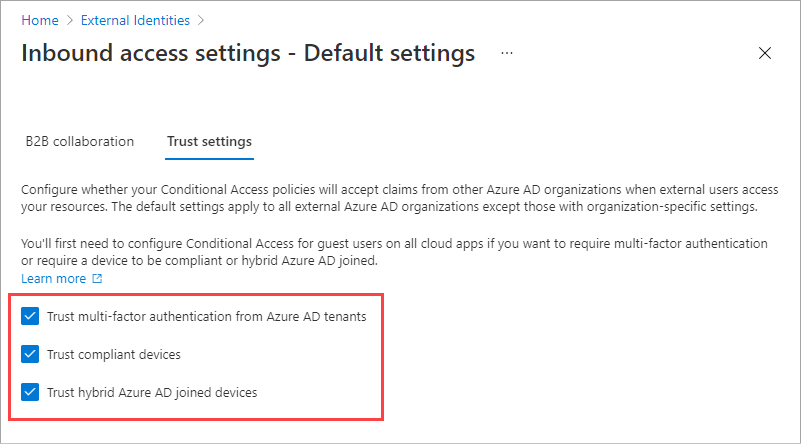
(This step applies to Organizational settings only.) Review the Automatic redemption option:
- Automatically redeem invitations with the tenant <tenant>: Check this setting if you want to automatically redeem invitations. If so, users from the specified tenant won't have to accept the consent prompt the first time they access this tenant using cross-tenant synchronization, B2B collaboration, or B2B direct connect. This setting only suppresses the consent prompt if the specified tenant also checks this setting for outbound access.

Select Save.
Allow users to sync into this tenant
If you select Inbound access of the added organization, you see the Cross-tenant sync tab and the Allow users sync into this tenant check box. Cross-tenant synchronization is a one-way synchronization service in Microsoft Entra ID that automates creating, updating, and deleting B2B collaboration users across tenants in an organization. For more information, see Configure cross-tenant synchronization and the Multitenant organizations documentation.
Modify outbound access settings
With outbound settings, you select which of your users and groups are able to access the external applications you choose. Whether you're configuring default settings or organization-specific settings, the steps for changing outbound cross-tenant access settings are the same. As described in this section, you navigate to either the Default tab or an organization on the Organizational settings tab, and then make your changes.
Sign in to the Microsoft Entra admin center as at least a Security Administrator.
Browse to Identity > External Identities > Cross-tenant access settings.
Navigate to the settings you want to modify:
To modify default outbound settings, select the Default settings tab, and then under Outbound access settings, select Edit outbound defaults.
To modify settings for a specific organization, select the Organizational settings tab, find the organization in the list (or add one) and then select the link in the Outbound access column.
Select the B2B collaboration tab.
(This step applies to Organizational settings only.) If you're configuring settings for an organization, select an option:
Default settings: The organization uses the settings configured on the Default settings tab. If customized settings were already configured for this organization, you need to select Yes to confirm that you want all settings to be replaced by the default settings. Then select Save, and skip the rest of the steps in this procedure.
Customize settings: You can customize the settings to enforce for this organization instead of the default settings. Continue with the rest of the steps in this procedure.
Select Users and groups.
Under Access status, select one of the following:
- Allow access: Allows your users and groups specified under Applies to to be invited to external organizations for B2B collaboration.
- Block access: Blocks your users and groups specified under Applies to from being invited to B2B collaboration. If you block access for all users and groups, this also blocks all external applications from being accessed via B2B collaboration.

Under Applies to, select one of the following:
- All <your organization> users: Applies the action you chose under Access status to all your users and groups.
- Select <your organization> users and groups (requires a Microsoft Entra ID P1 or P2 subscription): Lets you apply the action you chose under Access status to specific users and groups.
Note
If you block access for all of your users and groups, you also need to block access to all external applications (on the External applications tab).

If you chose Select <your organization> users and groups, do the following for each user or group you want to add:
- Select Add <your organization> users and groups.
- In the Select pane, type the user name or group name in the search box.
- Select the user or group in the search results.
- When you're done selecting the users and groups you want to add, choose Select.
Note
When targeting your users and groups, you won't be able to select users who have configured SMS-based authentication. This is because users who have a "federated credential" on their user object are blocked to prevent external users from being added to outbound access settings. As a workaround, you can use the Microsoft Graph API to add the user's object ID directly or target a group the user belongs to.
Select the External applications tab.
Under Access status, select one of the following:
- Allow access: Allows the external applications specified under Applies to to be accessed by your users via B2B collaboration.
- Block access: Blocks the external applications specified under Applies to from being accessed by your users via B2B collaboration.
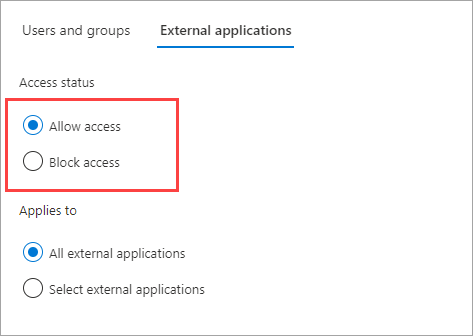
Under Applies to, select one of the following:
- All external applications: Applies the action you chose under Access status to all external applications.
- Select external applications: Applies the action you chose under Access status to all external applications.
Note
If you block access to all external applications, you also need to block access for all of your users and groups (on the Users and groups tab).
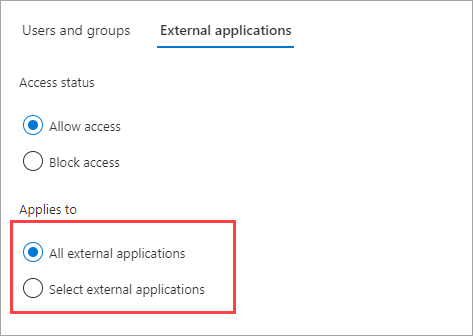
If you chose Select external applications, do the following for each application you want to add:
- Select Add Microsoft applications or Add other applications.
- In the search box, type the application name or the application ID (either the client app ID or the resource app ID). Then select the application in the search results. Repeat for each application you want to add.
- When you're done selecting applications, choose Select.
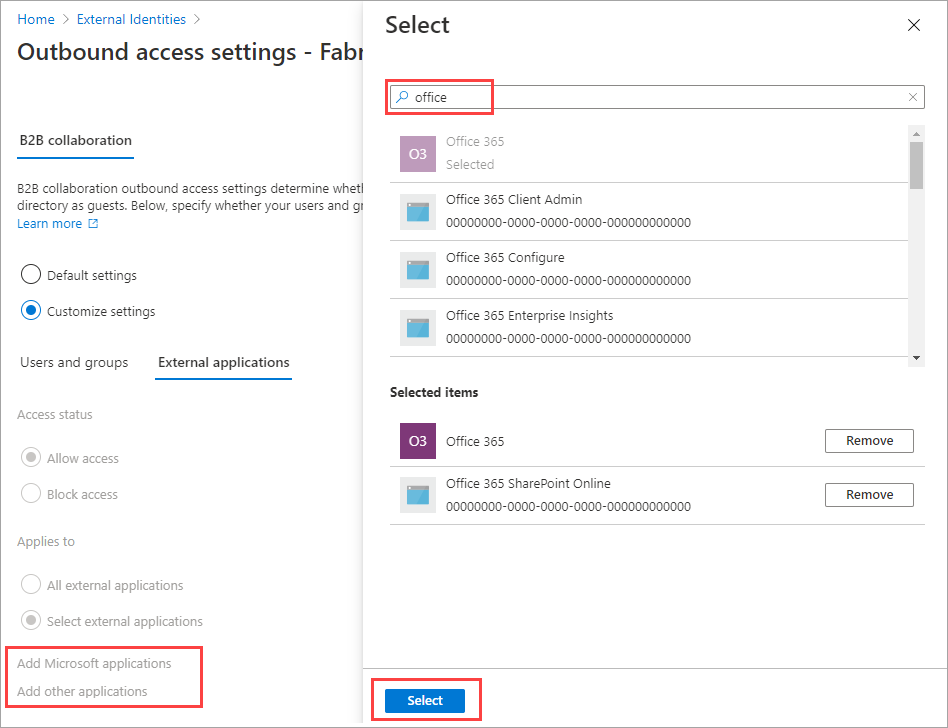
Select Save.
To change outbound trust settings
(This section applies to Organizational settings only.)
Select the Trust settings tab.
Review the Automatic redemption option:
- Automatically redeem invitations with the tenant <tenant>: Check this setting if you want to automatically redeem invitations. If so, users from this tenant don't have to accept the consent prompt the first time they access the specified tenant using cross-tenant synchronization, B2B collaboration, or B2B direct connect. This setting only suppresses the consent prompt if the specified tenant also checks this setting for inbound access.

Select Save.
Remove an organization
When you remove an organization from your Organizational settings, the default cross-tenant access settings go into effect for that organization.
Note
If the organization is a cloud service provider for your organization (the isServiceProvider property in the Microsoft Graph partner-specific configuration is true), you won't be able to remove the organization.
Sign in to the Microsoft Entra admin center as at least a Security Administrator.
Browse to Identity > External Identities > Cross-tenant access settings.
Select the Organizational settings tab.
Find the organization in the list, and then select the trash can icon on that row.
Next steps
- See Configure external collaboration settings for B2B collaboration with non-Azure AD identities, social identities, and non-IT managed external accounts.
- Configure cross-tenant access settings for B2B direct connect
Feedback
Coming soon: Throughout 2024 we will be phasing out GitHub Issues as the feedback mechanism for content and replacing it with a new feedback system. For more information see: https://aka.ms/ContentUserFeedback.
Submit and view feedback for


